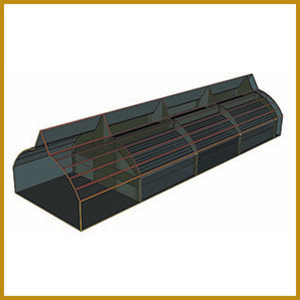Effect of envelope characteristics on the accuracy of discretised greenhouse model in TRNSYS

Published: 7 July 2022
Abstract Views: 1141
Appendix: 195
PDF: 378
HTML: 61
PDF: 378
HTML: 61
Publisher's note
All claims expressed in this article are solely those of the authors and do not necessarily represent those of their affiliated organizations, or those of the publisher, the editors and the reviewers. Any product that may be evaluated in this article or claim that may be made by its manufacturer is not guaranteed or endorsed by the publisher.
All claims expressed in this article are solely those of the authors and do not necessarily represent those of their affiliated organizations, or those of the publisher, the editors and the reviewers. Any product that may be evaluated in this article or claim that may be made by its manufacturer is not guaranteed or endorsed by the publisher.
Similar Articles
- Daniele Duca, Giuseppe Toscano, Ester Foppa Pedretti, Giovanni Riva, Sustainability of sunflower cultivation for biodiesel production in central Italy according to the Renewable Energy Directive methodology , Journal of Agricultural Engineering: Vol. 44 No. 4 (2013)
- Carlo Bibbiani, Patrizio Biagini, Federica Salari, Mina Martini, Dairy donkey: an alternative building layout , Journal of Agricultural Engineering: Vol. 48 No. s1 (2017): Special Issue
- Sergio Castellano, Pietro Santamaria, Francesco Serio, Solar radiation distribution inside a monospan greenhouse with the roof entirely covered by photovoltaic panels , Journal of Agricultural Engineering: Vol. 47 No. 1 (2016)
- Lucia Recchia, Daniele Sarri, Marco Rimediotti, Paolo Boncinelli, Enrico Cini, Marco Vieri, Towards the environmental sustainability assessment for the viticulture , Journal of Agricultural Engineering: Vol. 49 No. 1 (2018)
- Ian Torotwa, Qishuo Ding, Emmanuel Awuah, Ruiyin He, Biomimetic tool design improves tillage efficiency, seedbed quality, and straw incorporation during rototilling in conservation farming , Journal of Agricultural Engineering: Vol. 54 No. 1 (2023)
- Fang Huimin, Niu Mengmeng, Zhu Zhengbo, Zhang Qingyi, Experimental and numerical investigations of the impacts of separating board and anti-blocking mechanism on maize seeding , Journal of Agricultural Engineering: Vol. 53 No. 1 (2022)
- Adilkhan Niyazbayev, Francesco Garbati Pegna, Kanat Khazimov, Erik Umbetov, Kulmuhanbet Akhmetov, Zhadyra Sagyndykova, Marat Khazimov, Power need of an implement for removing polymer residues from the soil surface in Kazakh horticulture , Journal of Agricultural Engineering: Vol. 53 No. 3 (2022)
- Francesco M. Tangorra, Aldo Calcante, Energy consumption and technical-economic analysis of an automatic feeding system for dairy farms: Results from a field test , Journal of Agricultural Engineering: Vol. 49 No. 4 (2018)
- Timothy Denen Akpenpuun, Qazeem Opeyemi Ogunlowo, Wook-Ho Na, Prabhat Dutta, Anis Rabiu, Misbaudeen Aderemi Adesanya, Mohammadreza Nariman, Ezatullah Zakir, Hyeon Tae Kim, Hyun-Woo Lee, Dynamic neural network modeling of thermal environments of two adjacent single-span greenhouses with different thermal curtain positions , Journal of Agricultural Engineering: Vol. 55 No. 2 (2024)
- Andrea Dell'Agnese, Bruno Mazzorana, Francesco Comiti, Patricia Von Maravic, Vincenzo D'agostino, Assessing the physical vulnerability of check dams through an empirical damage index , Journal of Agricultural Engineering: Vol. 44 No. 1 (2013)
<< < 7 8 9 10 11 12 13 14 15 16 > >>
You may also start an advanced similarity search for this article.

 https://doi.org/10.4081/jae.2022.1420
https://doi.org/10.4081/jae.2022.1420







